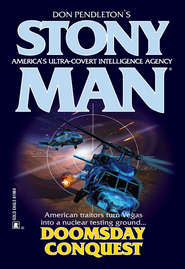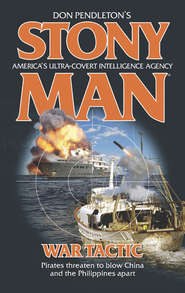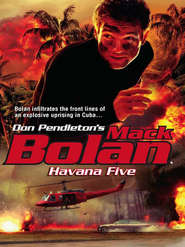По всем вопросам обращайтесь на: info@litportal.ru
(©) 2003-2024.
✖
Patriot Strike
Автор
Год написания книги
2019
Настройки чтения
Размер шрифта
Высота строк
Поля
“The clinic bombers?”
“Yep. With friends like those, you know he has to be pro-life. But lately he’s been concentrating on a home-grown bunch of mixed nuts calling themselves the New Texas Republic.”
“And we’re back to secession,” said Bolan.
“In spades. They started out running maneuvers, getting ready to defend us from some kind of weird Red Dawn scenario, plus armed patrols along the border for illegals. Now they claim the country can’t be saved. It’s too far gone with socialism, communism, fascism, Sharia law—they aren’t exactly scholars, if you get my drift.”
“And Ridgway’s keeping them afloat?”
“In high style,” said Brognola.
“Maybe he could send them to the moon.”
“Funny you’d mention that. About those rockets...”
Bolan felt a chill, although the morning sun was warm.
“In that last call from Jerod to his sister, there was mention of fissile material.”
The stuff that caused chain reactions in nuclear fission. The modern Big Bang.
“And Homeland still won’t touch it?”
“Not until we have a better case,” Brognola said.
“Okay. Let’s hear the rest.”
The rest—or most of it—was in files on a CD Brognola gave to Bolan for more leisurely perusal, while he waited for his flight to Texas. Adlene Granger was expecting him—expecting someone—for a meet in San Antonio at midnight. Why she’d picked the Alamo was anybody’s guess. As good a choice as any, if it worked; as bad as any other, if it didn’t.
At Dulles, Bolan found a corner seat near his departure gate, back to the wall, and used earbuds to keep anyone nearby from eavesdropping. The files, as usual, included still photos, video clips and facsimiles of documents.
First up was a biography of L. E. Ridgway, from his humble roots in Oklahoma through his first East Texas oil strike, the remarkable bad luck that haunted his competitors—fires and explosions, vandalism to their rigs and vehicles, some disappearances—and his advance to the top of the Fortune 500 list.
While his business and his wealth grew, the FBI began to notice his increased financing of far-right extremist groups—all dedicated to the proposition that America was under siege by enemies within; as well as standard adversaries like the Russians, North Koreans and Chinese. Ridgway and his compatriots apparently believed that every U.S. president since Herbert Hoover was a communist, a fascist or some whacky, nonsensical combination of the two.
These extremists hated government, minorities, the very concept of diversity and fumed nonstop about ephemeral conspiracies to persecute white Christian men. As for the ladies, the members thought they should just stay home, cook dinner, tend to the kids—and, if required, help clean the guns.
Not all of the yahoos were just talk, of course. Several groups that Ridgway had supported over time were linked to acts of domestic terrorism. Everybody knew about the Klan’s shenanigans—cross burnings, bombings, drunken drive-by shootings.
But Ridgway had also been connected to a handful of so-called militia groups that had stockpiled illegal weapons, threatened government officials and conspired on various occasions to attack public facilities: federal buildings, natural gas pipelines—never Ridgway’s—and power plants.
One “Aryan” gang wanted to poison a midsized city’s water supply in Arkansas, but state police foiled their plan. None of the indictments from those cases ever touched Ridgway or Lone Star Petroleum, but Ridgway lurked in the background like a fat old spider spinning its web.
The move into privatized aerospace technology had been a break from Ridgway’s normal style. He was literally going where no man had gone before, hiring personnel laid off by NASA, planning to conquer space and turn a tidy profit in the process. With billions to spend, he had acquired a decommissioned space shuttle, set his team to work improving it and pronounced it ready to soar.
Media reports claimed Lone Star Aerospace was near completion of the solid rocket boosters necessary for a launch, along with an overhauled Lunar Excursion Module—the LM-14, scrapped when plans for Apollo 19 fell through—and a snazzy Lunar Roving Vehicle. Show up with a truckload of cash and anyone could drive a dune buggy around the dark side of the moon.
There was nothing on the CD about fissile material. Bolan would have to hear that from the Ranger, assuming there was anything to tell.
From Ridgway, he moved on to Hal’s files on the New Texas Republic, a secessionist militia outfit based in Tom Green County, near San Angelo, Texas. Headquarters was a rural compound squatting on scrubland west of town, home to eighty-odd families, by the FBI’s estimate.
The NTR’s founder and crackpot-in-chief was Waylon David Crockett, a self-proclaimed descendant of Davy Crockett, one-time Tennessee congressman and Alamo martyr. That genealogical link had never been confirmed officially, but Waylon’s adherents in the NTR were satisfied.
Crockett had grown up poor and tough in Brownsville, on the Tex-Mex border. Starting at the tender age of fifteen, he had been arrested nineteen times, convicted on two juvie raps and three adult charges. The most serious, drug dealing, had sent him to Huntsville’s prison for a five-year stay, but he was paroled in three.
Crockett had found the Lord while he was caged, and came out preaching a mix of politics and ultrafundamentalist religion, picking up disciples as he had roamed across the countryside. He first hooked up with Ridgway shortly after 9/11, when Crockett joined the Midland Militia, ready to defend his state against a rampaging Islamic horde that never showed up. Three years later he’d branched out on his own with the NTR and welcomed Ridgway’s whole-hearted financial support.
The New Texas Republic hadn’t been accused of any criminal infractions yet, but it was on watch lists maintained by the FBI, ATF and Homeland Security. Budgetary constraints and Crockett’s strict screening process for new recruits had foiled any covert infiltration so far, but there were always rumors: hidden arsenals, inflammatory words, dire schemes.
Crockett’s second in command was Kent Luttrell, ex-Klansman, ex-security guard for the Aryan Nations “church” compound in Idaho, ex-member of California’s Minuteman Project—the “citizens’ vigilance” border patrol praised by Governor Schwarzenegger in 2005 for doing “a terrific job” against illegal immigrants.
Five years running, Kent had made news for holding candlelight prayer vigils on June 11, the date when Oklahoma City bomber Timothy McVeigh was executed for mass murder. Now Kent was the NTR’s sergeant-at-arms, enforcing discipline and supervising details of the minuscule “republic’s” daily operations for his chief.
The two of them made a peculiar pair. Crockett was five foot five and wiry, had a Charlie Manson smile and looked like he’d forgotten how to use a comb around the time he quit high school. Most of his photos showed a face with sunken cheeks and stubble, bushy brows and dark eyes possessed of a thousand-yard stare. He wasn’t quite the Unabomber, but a stranger could have been excused for thinking Crockett and Kaczynski had been separated at birth.
Luttrell, by contrast, was a strapping six foot five, clearly a bodybuilder, with a blond buzz cut and narrow brows to match. His thick arms swarmed with typical tattoos—iron crosses, lightning bolts and swastikas, the usual—while the police files said his broad back bore a life-sized portrait of Der Führer dressed in shining armor, battle flag unfurled.
That had to have stung.
Photos depicting Crockett and Luttrell together showed a Mutt and Jeff team—almost comical until you thought about their records and their crazed philosophy. They had been dangerous as individuals, before they met. Together, Bolan reckoned, they were even worse.
The New Texas Republic had an estimated 650 members, half of those residing more or less full-time at Crockett’s Tom Green County compound. A few of the others were locked up on various charges, mostly weapons’ violations or domestic violence, with the remainder at large throughout Texas. Bolan viewed the available mug shots and candid photos, memorizing the angry faces for future reference, in case they crossed his path.
Finally he turned to Adlene Granger’s file. It surprised him to discover that she’d joined the U.S. Army out of high school, age eighteen, with the announced intent of making a career in uniform. The 9/11 strikes occurred when she was two years in, and she’d been posted to Afghanistan.
Two tours over there, with action around Kandahar and Tora Bora, had changed her mind about an army life, but not the uniform. She’d separated from the service at twenty-two and had joined the Texas Rangers when they had started taking on women to prove they were diverse. She’d earned her sergeant’s stripes last year, something to celebrate.
Now she had lost the final member of her family to unknown gunmen. She knew he needed to report something urgent, but he wouldn’t share details on the telephone. Ridgway was mentioned and the NTR, something about fissile material, but Jerod Granger had not lived to pass on anything more. Adlene had considered talking to her boss in Austin, then decided she should try her Uncle Hal, instead.
Bolan had no idea what he would find in Texas. Maybe nothing but the paranoid delusions of a dead man—but if that were true, who’d want him dead? From the description of his body and the crime scene, it had been a more-or-less professional elimination. At the very least, Bolan knew the shooters had experience. They’d killed before and had gotten away with it.
But maybe not this time.
Bolan wasn’t, strictly speaking, in the vengeance business. He wouldn’t mind taking out the team that had killed Jerod Granger—three different weapons had been confirmed—but that didn’t rate a call from Stony Man or a flight to San Antonio. He would assess the situation once he’d heard the Ranger’s story and decide on where to go from there.
Full speed ahead or back to Washington with a report for Hal, scrubbing the job.
If Ridgway, Lone Star and the NTR were up to something wicked—planning a catastrophe, in Jerod Granger’s words—Bolan would see the mission through. If it was all just smoke and mirrors, another zany pipe dream from the “New World Order” crowd, he’d walk away.
He heard his flight’s first boarding call, erased the CD and switched off his laptop, then headed toward the gate, hoping he wouldn’t have to share his row with some behemoth or an infant that would wail for fourteen hundred miles, across four states. A little peace and quiet would be nice.
But something told him that it wouldn’t last for long.
Chapter 3
San Antonio—Now
Rolling east on Crockett, Bolan soon found himself approaching Bowie Street. He could go north or south from there, not straight, since one-way Elm Street turned to meet him up ahead, barring access to the north-south lanes of Interstate 37.











